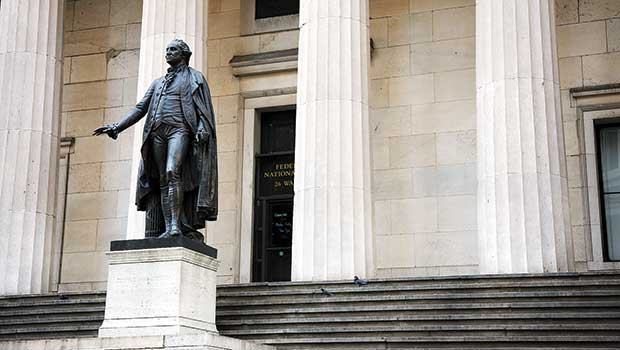George Washington: Slave-breeder
Unsavory past often glossed over in historical interpretation

NEW YORK — America’s unease with its slave-holding past came into sharp relief during a recent encounter in Federal Hall, a Wall Street landmark with an eight-foot bronze statue of George Washington on the front steps.
The Virginia planter took the oath of office standing on the balcony of the original Lower Manhattan building to become president and lived close to the East River during his two years in the nation’s first capital. His 20-member household staff included seven slaves brought from the general’s Mount Vernon estate.

A portrait of George Washington by Gilbert Stuart.
Wandering into the rotunda of the Pantheon-style building, I asked a pair of Park Rangers about Washington’s whereabouts between the end of the Revolutionary War in 1783 and his 1789 inauguration. “Did he take part in the Philadelphia debates over the Constitution or did he go back to breeding slaves at Mount Vernon?” I asked.
One of the rangers, a petite woman, visibly blanched. Her colleague managed a wan smile.
“Well, he might have been a slave-owner but that hardly makes him a slave-breeder,” she sputtered.
“My recollection is that he sizably increased his slave-holdings as children were born on the plantation,” I said. “There may not have been selective breeding involved but by any definition the increase of slave stock through birth is slave-breeding.”
She thrust her face towards me. “I wear this badge proudly,” she said, gripping the rectangular totem above the pocket of her ranger blouse. “I will not accept such a view of George Washington.”
At a time southern cities are removing monuments to icons of the Confederacy, it’s wishful thinking to believe that engrained beliefs can be hauled away along with the bronze, marble and granite figures of long-dead secessionists. Removing them is just the first step in the process of coming to grips with the textured truth of history.
No one has yet suggested toppling Washington’s statue like some bewigged Saddam Hussein. An honest accounting of his life-long ties to slavery may reduce his heroic stature but in no way diminishes the reality of what he risked as a rebel of the crown and how his leadership of an ill-equipped militia army defeated the greatest empire on the planet.
But facts do get in the way of indiscriminate idolatry. At the age of 11, Washington inherited 10 slaves and owned 123 at the time of his death in 1799. His wife owned another 153. At various times, Washington expressed hopes for the end of slavery and was said to treat his slaves “humanely,” but never in his lifetime freed a single one of the hundreds living at Mount Vernon.
As president, he signed the Fugitive Slave Act and zealously pursued the capture of his own runaways, including his wife’s chief handmaiden, Ona Judge, who fled to Portsmouth, N.H., after learning that Martha Washington planned to give her away as a wedding gift to her granddaughter.
After the capital was moved from New York to Philadelphia, Washington discreetly rotated his adult slaves out of Pennsylvania every six months in order to avoid triggering automatic freedom for slaves over age 28 living more than a half-year in the Quaker State where abolitionist sentiments were strong.
Whatever misgivings our first commander-in-chief had about slavery, he never exalted principles over property.
There wasn’t much time to go into such details with the offended ranger. She had rushed towards the exit shortly after our exchange began.
Back out on the steps of Federal Hall, I took a left towards Pearl Street and Fraunces Tavern, where Washington, attended by slaves, had bid a tearful farewell at the end of the war to the loyal officers who fought by his side to give birth to a new nation.
The painful reality tour continues.
Brian Wright O’Connor is a former Banner managing editor and a freelance writer.






